Introduction
General Overview
The Nikon D800 effectively functions as Nikon’s flagship camera. While the Nikon D4 is technically the “top” camera in the Nikon range (DxOMark side by side comparison), the D800 has the highest megapixel count and is widely regarded as being the best all-round model in the range.
Given its price-point, the natural competitor is the Canon EOS 5D Mark III, but this “only” sports 22.3megapixels in comparison to the Nikon D800’s 36megapixels. Once the Nikon D800 was tested in the labs, it became clear that with a whole range of lenses, the Nikon D800 was out-performing every other camera tested (5D Mark III lens results are not yet available)
Lens efficiency
With the increase in megapixel counts on camera sensors, there is ever more stress placed on the optical system that begins with the lens. If the sensor is able to resolve more detail, then any imperfections in the lens are more obvious. Fitting a poor quality lens to a high quality camera sensor is therefore actually a false economy because you do not maximize the capability of the camera sensor.
To give you an idea of which lenses are best on a given camera, you can look at the lens-camera efficiency. That is the ratio between the pixel count of the camera and P-Mpix score. This ratio depends on three factors - the sensor performance, the quality of the anti-aliasing filter in front of the sensor and the quality of the lens. By looking at the efficiency of a series of lenses on the same sensor, it is possible to compare the relative quality of each lens in terms of how it performs compared to its peers.
Taking this comparison a stage further, it is also possible to compare the efficiency score between different cameras using the same lens. With the megapixel race still on-going between the different camera manufacturers, providing an efficient lens, in other words one that offers the best quality for a given pixel count is ever more of a challenge for the lens manufacturers.
As an end user, these results benefit you too – while camera manufacturers claim that each new model gives you better image quality, if you already have a large collection of lenses, you can see what you gain, in terms of final image quality, by switching camera. It could be that changing to a higher resolution model actually shows up the flaws in your lens and so your net gain is minimal in changing camera models.
To illustrate this point about lens-camera efficiency, the graphs above show lenses tested on the Nikon D800 and D3X and the efficiency of those lenses mounted on those same cameras. What is very interesting, and indeed illustrative, is that while the P-Mpix scores for lenses mounted on the D800 are higher than when they are mounted on the D3X, the efficiency scores on the D800 are comparatively much lower.
The conclusions from this are simple – the Nikon D800 is definitely the leader in terms of P-Mpix score and DxOMark ranking, however the overall sharpness and performance of lenses on that sensor is not as good as it could be. It could be that the Anti-Aliasing filter is a little bit too strong adversely affecting the sharpness results. Perhaps with a slightly less restrictive AA filter, the efficiency results would have been improved.
So is switching from the 24megapixels of a D3X to the 36 megapixels of a D800 really worth it? Well, in overall terms, the average improvement in P-Mpix score of a lens on a D800 compared to a D3X, is around 10%. This is not a negligible improvement and should therefore not be ignored. However, bear in mind that this is an average performance increase, so some lenses such as the high-end prime models will show a greater improvement, while lower end zoom and super zoom models will not benefit anywhere near as much.
Beyond the sharpness scores, the other benefit of the Nikon D800 sensor is the improvement in low light, which must also be considered when looking at lens performance – while the P-Mpix score effectively measures sharpness, looking at the overall DxOMark score takes account of the improved sensor noise performance of the Nikon D800. If we look at the percentage improvement of DxOMark score in moving from the D3X to the D800, we see the gain jumping up to 15%.
Conclusion
Upgrading to D800 will indeed give you the sharpest result from all full frame gears published by DxOMark. Definitely worth it if you are already using the sharpest lenses available on Nikon mounts. However, don’t expect sharpness improvement proportional to pixel count.
Stay tuned for the next part of this review where we’ll look at the standard focal length lenses, zooms and primes as well as the macro lenses tested in the labs.
In this second part of the Nikon D800 and lenses review, we’re looking at the standard focal lengths. Within this group, there is a very wide range available. When searching for a standard lens, you have the option of both prime and zoom, depending on what suits your needs best. To help make it easy to select the right lens, we’ll look at the 50mm primes, 85mm primes, macro lenses and finally the standard focal range zooms.
In total, the DxOMark labs have tested 28 lenses within this focal range, 22 of which are prime lenses from 50mm to 105mm, and 6 fall within the standard zoom category with focal lengths around the 24-70mm type focal range.
An interesting factor found through the labs is that the 50mm and 85mm focal lengths tend to outperform all other prime lenses tested, with the 85mm and 105mm lenses scoring particularly highly. In fact, the highest scoring lenses tested by the DxOMark labs have all been 85mm primes – certainly something to consider if you’re looking for the ‘best’ lenses on any camera.
In addition to this, the often repeated line that prime lenses are better than zoom lenses is once again borne out here, with prime lenses outperforming zoom lenses by between 20 and 30% – a quite significant difference that you may feel more than justifies the lack of versatility provided by prime lens models.
50mm
If you’re looking for a true standard lens, then 50mm is the focal length you should be choosing. Within the 50mm options, DxOMark have tested 7 different models. There are three models that come out on top, but the top five are all very close.
| Lens | Price ($) | DxOMark Score |
| Sigma 50mm F1.4 EX DG HSM Nikon | 499 | 32 |
| Nikon AF Nikkor 50mm f/1.4 D | 329 | 32 |
| Nikon AF-S Nikkor 50mm f/1.4 G | 448 | 32 |
| Carl Zeiss Makro-Planar T 50mm f/2 ZF2 Nikon | 1280 | 31 |
| Nikon AF-S Nikkor 50mm f/1.8G | 219 | 31 |
| Nikon AF Nikkor 50mm f/1.8 D | 134 | 29 |
| Carl Zeiss Planar T 50mm f/1.4 ZF2 Nikon | 725 | 26 |
The three top scorers are from Nikon and Sigma – the Nikon AF Nikkor 50mm f/1.4D, Nikon AF-S Nikkor 50mm f/1.4G and Sigma 50mm f/1.4 EX DG HSM. All three managed 32 on the DxOMark scores putting them at the top of the list for 50mm lenses on the D800. Strangely the Sigma 50mm lens is the most expensive of the trio, but given that the price difference is not much more than $100 between the three, unless budget is a real concern, this and the Nikon 50mm f/1.4G are the two top choices. That said, the performance of the Nikon 50mm f/1.8G makes it a very worthy consideration if budget is a concern.
85mm to 105mm
In this focal range, DxOMark have tested 14 different lenses, so your choice for a portrait lens is huge.
| Lens | Price ($) | DxOMark Score |
| Nikon AF-S Nikkor 85mm f/1.4G | 2199 | 40 |
| Nikon AF-S Nikkor 85mm f/1.8G | 690 | 40 |
| Carl Zeiss Makro-Planar T 100mm f/2 ZF2 Nikon | 1840 | 36 |
| Samyang 85mm f/1.4 Aspherical IF Nikon | 328 | 36 |
| Sigma 85mm F1.4 EX DG HSM Nikon | 969 | 35 |
| Nikon AF Nikkor 85mm f/1.4 D IF | 1230 | 33 |
| Nikon AF-S VR Micro-Nikkor 105mm f/2.8G | 890 | 32 |
| Nikon AF Nikkor 85mm f/1.8D | 460 | 32 |
| Carl Zeiss Planar T 85mm f/1.4 ZF2 Nikon | 1280 | 29 |
| Tamron SP AF 90mm F/2.8 Di MACRO Nikon | 460 | 29 |
| Sigma 105mm F2.8 EX DG Macro Nikon | 640 | 28 |
| Sigma 105mm F2.8 EX DG OS HSM Nikon | 969 | 28 |
Within this range, the story is much the same as with the 50mm lenses, with two Nikon lenses taking top honors and surprisingly a Samyang model rounding out the top three. In this case, it’s the Nikon AF-S Nikkor 85mm f/1.8G, the Nikon AF-S Nikkor 85mm f/1.4G and the Samyang 85mm f/1.4 Aspherical IF. The two Nikon lenses both scored the same on the DxOMark overall metrics, managing 40, while the Samyang model is fractionally behind on 36. In terms of choice, if you want the wider aperture of the f/1.4 it will cost you, with that lens coming in at nearly $2200, but it will provide the highest overall sharpness at 22P-Mpix. However the slightly slower, but optically just as good, 85mm f/1.8G looks to be a fantastic bargain at only $690 and offers less vignetting, chromatic aberration and distortion than its more expensive stable-mate, while losing out only slightly in overall sharpness. In terms of selecting one of these models, it is very hard to choose against the cheaper option because the more expensive model does not do enough to justify the higher price tag.
If the Nikon 85mm f/1.8G doesn’t fit your budget, then take a long look at the Samyang 85mm f/1.4 Aspherical IF. It lacks any autofocus ability, but a score of 36 is remarkably good for such a low priced lens. If you can live with the manual limitations, it is worth serious consideration.
50mm to 105mm macro lenses
If a macro function is important to you, then the best macro lens around this focal range is the Carl Zeiss Makro-Plana T 100mm f/2 ZF2 Nikon, which scored 36. However, the cost is high at around $1840 and the lack of autofocus ability means it is one for the purist who is willing to put up with the fully manual nature of the lens. The Nikon AF-S VR Micro-Nikkor 105mm f/2.8G IF-ED however is a slightly more budget conscious choice at $890. It scored almost as well at 32 and has the added benefit of full AF and a vibration reduction system to help avoid camera shake – something that is even more obvious in macro photography.
If you prefer working closer in to your subjects, then it is also worth considering the Carl Zeiss Makro-Planar T 50mm f/2 ZF2 Nikon. This is a 50mm macro lens, that scored 31 in the overall DxOMark scores and managed the joint highest sharpness score for all the macro lenses tested, at 17P-Mpix. At $1280USD it follows the familiar Zeiss trend of being at the top of the price bracket, but the quality is unquestionable and if you are looking for a macro lens around this focal length, then the lack of autofocus should not necessarily put you off.
Standard Zoom lenses
Within those tested, it is clear that the Tamron SP 24-70mm f/2.8 Di VC USD and Nikon AF-S Nikkor 24-70mm f/2.8G ED are the best choices for image quality. For zoom lenses to score 29 and 28 is pretty impressive, especially given the high resolution of the camera, where flaws caused by compromises in optical design are much more obvious. At $1,800, however, the Nikon 24-70mm f/2.8 is pricey. The new Tamron, sporting a pricetag of $1,299, is definitely a viable choice, given the circumstances.
Within those tested, it is clear that the Nikon AF-S Nikkor 24-70mm f/2.8G ED is the best choice for image quality. For a zoom lens to score 28 is pretty impressive, especially given the high resolution of the camera, where flaws caused by compromises in optical design are more obvious. At $1800 it is expensive though.
Below these two lenses, there are three models that all scored 23. They are the the Tamron 28-75mm f/2.8 XR Di LD Aspherical (IF), the Sigma 24-70mm f/2.8 IF EX DG HSM Nikon and the Nikon AF Zoom-Nikkor 24-85mm f/2.8-4D IF. Of the three, the Sigma lens comes out on top in the sharpness test, managing a very respectable 16P-MPix that even beats the Nikon 24-70mm f/2.8G ED mentioned above. Sadly, it is hampered by its chromatic aberration, which scores a very poor 26µm. At $899, it is also the most expensive of the three.
If you’re looking for the real “budget star” of the trio, then the Tamron is the best choice With a sharpness score of 13M-Pix, it beats the Nikon and is the cheapest ($499) of the three by a noticeable margin. For it to match the scores of several more expensive lenses is a fantastic achievement, and it should get the nod as the best bargain of the bunch.
Conclusion
Since they have such different uses, there can be no clear winner in these groups, so the results should be used to help you build a kit of lenses to cover your shooting needs. Clearly the best image quality possible comes from the 85mm lenses, though if you don’t shoot portraits, you may well find an 85mm lens surplus to requirements.
In part 3 of this series we’ll be looking at the telephoto lenses as well as the super-zoom models that provide a lot of versatility. The question is, how will they stand up to the rigors of being mounted to the Nikon D800?
In this third section of the Nikon D800 review, we’ll be looking at the telephoto lenses. These are models with a focal range of 70-200mm or 70-300mm and we have also included the super-zoom or “all-in-one” lenses with focal ranges from 28-300mm.
Of the lenses currently tested by DxOMark, there is one or two that are not yet available. Notably, prime lenses around 200mm or longer have not been tested as well as (at Mid-March 2013) the Nikon 70-200mm VR II lens. However, these will be added in the coming months as the labs get to do their testing.
As we’ve seen in the standard lens test results, when using the Nikon D800, it pays to look for the best lenses, because the camera is so demanding of lens performance. As we’d expect, when comparing the lenses in these groups to the best standard prime lenses, the telephoto models lose out. However, interestingly, the 70-200mm lenses do score approximately similarly to the standard zoom lenses, suggesting that optical quality is not dropping off that sharply in this focal range.
70-200mm
The 70-200mm focal range is exceptionally popular – for good reason. This focal range covers a lot of requirements and is used regularly by photographers in most genres. As we’ve seen, the fact that these lenses tend to perform better than other lenses within this class has also made them a favorite choice.
The best 2 lenses tested are both Nikon models: in the Overall score, the Nikon 70-200mm f/2.8G VRII and the Nikon 70-200mm f/4G ED VR come out on top with scores of 29 and 28, respectively. With a price of $1,399, the Nikon 70-200mm f/4 ED VR is not only a top choice, but also a good bargain – as much as a lens costing over $1,000 can be considered a bargain.
If you need a faster maximum aperture than f/4, then the Nikon 70-200mm f/2.8 VR II is the best in its class. If the Nikon is out of your price range, the $770 Tamron 70-200mm f/2.8 Di LD (IF) and the less-recent $1,850 Nikon 70-200mm f/2.8G IF-ED both score a very good DxOMark score of 26. In all areas, the two are seemingly equal, so your choice will eventually come down to brand loyalty and price as much as any image quality concerns.
The one thing to keep in mind is that the latest Tamrom 70-200mm f/2.8 lens has not yet been tested. Once the lens has had its turn going through our labs, we expect to possibly see some shift in these two last places, especially since the Tamron lens did so well when tested on a Canon-mounted version.
Apart from the Nikon f/4 lens mentioned above, the Tamron also makes a good value for money option given its retail price of $770. If the slight loss in image quality compared to the Nikon f/4 lens does not bother you, the Tamron model could even be considered the best choice when price and performance are weighed up.
70-300mm
The 70-300mm focal range is often seen as a “kit lens” length as many double zoom camera-lens combinations include a 70-300mm lens. They are effectively cheap lenses that offer a decent focal length, but generally the compromises made in achieving the large focal range mean image quality suffers.
| Lens | Price ($) | DxOMark Score |
| Nikon AF-S VR Zoom Nikkor 70-300mm f/4.5-5.6G IF-ED | 669 | 20 |
| Nikon AF Zoom Nikkor 70-300mm f/4-5.6D ED | 196 | 20 |
| Sigma 70-300mm F4-5.6 DG OS Nikon | 359 | 19 |
| Tamron SP 70-300mm F4-5.6 Di VC USD Nikon | 449 | 19 |
Of the four lenses, the Nikon AF-S VR Zoom-Nikkor 70-300mm f/4.5-5.6G IF-ED comes out as the top choice for two reasons – firstly, it has the highest sharpness score of the quartet, managing 12P-Mpix and secondly, because it features Nikon’s Vibration Reduction system. With such a long focal range, having VR is a real benefit in achieving sharp shots while handholding and so this lens makes the best choice.
However, if paying $669 for a lens like this seems a bit too expensive, the best value for money option is the Sigma 70-300mm f/4-5.6 DG OS. This is for largely the same reasons as the Nikon lens – it puts in the second highest sharpness score and also includes an image stabilizer function. Priced at $359 it is a good choice if value for money is your major concern.
Super Zooms
Buying a Nikon D800 and then fitting a super-zoom lens may seem a bit like buying a supercar and running it on cheap fuel, but there is a place for these lenses as they are functional, especially if you are travelling and do not want to carry the weight of several lenses in a kit. However, as with the 70-300mm lenses, there is a compromise to be made in the lens design – if not, we’d all be using 28-300mm lenses!
| Lens | Price ($) | DxOMark Score |
| Sigma 120-400mm F4.5-5.6 DG APO OS HSM Nikon | 999 | 19 |
| Nikon AF Zoom Nikkor 28-200mm f/3.5-5.6G IF-ED | 300 | 17 |
| Nikon AF-S Nikkor 28-300mm f/3.5-5.6G ED VR | 1050 | 17 |
| Tamron 28-300 F3.5-6.3 XR I A Nikon | 600 | 16 |
Of the four lenses tested by DxOMark, there are two that really stand out. The first is not a true super-zoom in the sense of being an all-in-one lens, but instead offers the longest focal length that will be of interest especially to those shooting sports or wildlife. It is the Sigma 120-400mm f/4.5-5.6 DG APO OS HSM. With a sharpness score of 12P-Mpix, it beats the other lenses and doesn’t really lose out greatly in any other area, hence why it top scores with a DxOMark Overall score of 19.
For a true super-zoom, the Nikon AF-S Nikkor 28-300mm f/3.5-5.6G ED VR makes the best choice. 10P-Mpix is not great when compared to shorter focal lengths or prime lenses, but within the compromises of the super-zoom design, it is not a bad result. At $1050 though, it is the most expensive lens tested in this category, though it does include Nikon’s VR system. Because of the high cost, unless you really need the extended focal range, you may do better to look elsewhere.
For a value for money option, the Nikon AF Zoom-Nikkor 28-200mm f/3.5-5.6G IF-ED offers a good alternative. While it lacks the 300mm focal length, the much lower cost of $300 makes it an attractive proposition as in a direct head-to-head with its more expensive stablemate, the only area it really loses out is in the chromatic aberration tests, which is why its overall score has suffered.
Conclusion
With a Nikon D800, your best option for the highest quality images in this focal range is to stick to the 70-200mm models. As ever, these offer the highest sharpness scores in the range and best image quality overall. The other lenses have their place in the kit bag, but they suffer from too many compromises to make them an ideal choice when trying to maximize the performance of the Nikon D800.
In the final section, we’ll look at the wide-angle lenses, both primes and zooms. Stay tuned!
In this final section of the Nikon D800 lens test review, we’ll be looking at the wide-angle lenses. For clarity, we are classing any lens with a focal length up to 35mm as wide-angle. Within this we have broken lenses down into the ultra-wides with focal lengths below 21mm, wide-angle between 21mm and 35mm and zoom wide-angles with a focal length up to 35mm.
The thing to remember is that with these categories, zoom lenses will always score lower than prime lenses. This is a function of the optical design limits of wide-angle lenses, though it should be noted that some prime wide-angles do manage to score almost as well as standard prime lenses.
The reasons for the lower wide-angle scores are simple – wide angles tend to suffer more with distortion, vignetting and sharpness across the frame. In the ultra-wide angle lenses, the differences are very marked, with ultra-wide angle zoom lenses scoring 20% lower than the better wide-angle prime lenses – a very significant drop. However, if you need an ultra-wide angle lens, this is something you will have to accept.
Ultra-wide
| Lens | Price ($) | DxOMark Score |
| Carl Zeiss Distagon T* 2.8/15 ZF.2 Nikon | 2950 | 27 |
| Sigma 20mm F1.8 EX DG ASP RF Nikon | 629 | 26 |
| Carl Zeiss Distagon T 21mm f/2.8 ZF2 Nikon | 1732 | 25 |
| Samyang 14mm f/2.8 IF ED UMC Aspherical Nikon | 409 | 25 |
| Nikon AF Nikkor 20mm f/2.8D | 570 | 25 |
| Carl Zeiss Distagon T 18mm f/3.5 ZF2 Nikon | 1395 | 22 |
| Sigma 14mm F2.8 EX Aspherical HSM Nikon | 749 | 20 |
If you are looking for an ultra-wide angle lens, then for the best image quality, the Carl Zeiss Distagon 15mm f/2.8 offers the highest sharpness levels, with a P-Mpix score of 17. The one thing to remember with this lens though, is that it does not offer any AF as it is a manual lens. Provided you are willing to work within these limitations, it is the best choice in terms of optical performance, with a DxOMark Overall score of 27 and a sharpness score of 17P-Mpix.
If you are looking for a lens that is not as expensive, then for value for money, the Sigma 20mm f/1.8 EX DG ASP makes a good choice at substantially less cost than the Zeiss 15mm.
Wide-angle
Within the wide-angle lenses, the best overall score again comes from a non-Nikon lens in the shape of the Sigma 35mm F1.4 DG HSM A recently reviewed on our website. The second lens is the Carl Zeiss 35mm f/1.4 but as with the previous Carl Zeiss lens, this is a manual model with no AF.
| Lens | Price ($) | DxOMark Score |
| Sigma 35mm F1.4 DG HSM A Nikon | 899 | 39 |
| Nikon AF-S Nikkor 24mm f/1.4G ED | 2200 | 34 |
| Samyang 35mm F1.4 AS UMC Nikon | 599 | 34 |
| Carl Zeiss Distagon T 35mm f/1.4 ZF2 Nikon | 1843 | 34 |
| Nikon AF-S NIKKOR 28mm f/1.8G | 699 | 33 |
| Carl Zeiss Distagon T 35mm f/2 ZF2 Nikon | 1005 | 33 |
| Nikon AF-S NIKKOR 35mm f/1.4G | 1797 | 33 |
| Carl Zeiss Distagon T 28mm f/2 ZF2 Nikon | 1283 | 29 |
| Nikon AF Nikkor 28mm f/2.8D | 280 | 26 |
For value for money choices, the Nikon AF-S 28mm f/1.8G and the Samyang 35mm f/1.4 AS UMC are both worth considering, the Nikon model actually being the best of the three in terms of sharpness, scoring 21P-Mpix to the Zeiss lens’ 17P-Mpix.
Interestingly, the Samyang does make a very compelling argument – it is a little lower placed in terms of sharpness, scoring 15P-Mpix, however it matches the other two lenses very well in all other areas. Given the low price of $599 (compared to the $1843 for the Zeiss and $699 for the Nikon) it offers very good value for money – provided you are willing to sacrifice autofocus.
The Nikon is probably the best all-rounder of the three. While it may not match the sharpness of the Zeiss, and its transmission score is lower than both the Zeiss and the Samyang, the fact it is a dedicated lens, with full autofocus may well make it the best choice in real-world use.
Zooms
As far as IQ is concerned, the 14-24mm f/2.8 is a stellar performer for this range of focal length. This zoom is the only one that competes with the better primes. Despite its higher price tag, its high scores in image quality definitely justify purchasing this lens.
In terms of sharpness, both the Tokina AT-X 16-28mm f/2.8 PRO FX Nikon and Nikon AF-S Nikkor 16-35mm f/4G ED VR lenses are evenly matched on 14P-Mpix. However, the faster maximum aperture of the Tokina and the lower distortion and chromatic aberration scores see it come out as the best choice scoring 24 to the Nikon’s 23. The fact that it is nearly $400 cheaper ($849 vs $1260) merely serves to make it an even better value for money option. In the Nikon’s favor though, there is a vibration reduction system included, though this is usually less useful in wide-angle shooting.
Conclusion
Depending on your preferences for primes vs. zooms, you’ll make your own mind up about which lenses to select from this group. However, if you are looking for the best quality, the general advice is to stick to the prime lens options.
Throughout these Nikon D800 lens tests, we have given you an overview of which lenses are best when matched to the high resolution sensor on the camera. The over-riding lesson is that the sensor is very demanding on lenses and while manufacturer own lenses are well regarded, if you’re looking for the highest image quality, then it pays to look to some of the third party options as well.


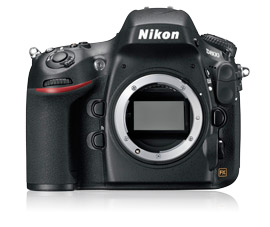






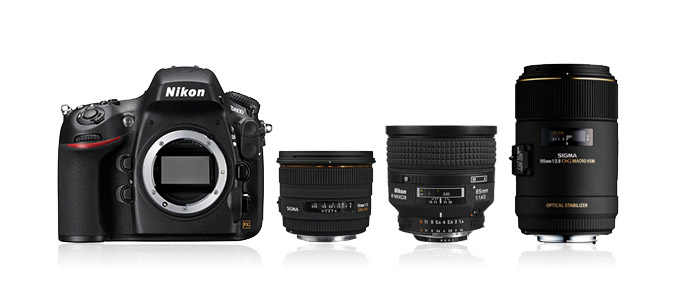









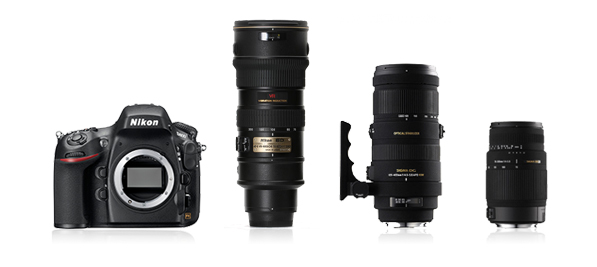





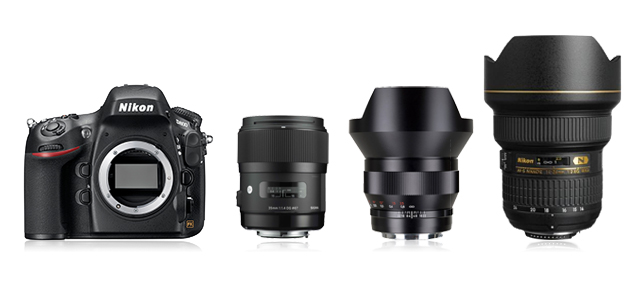




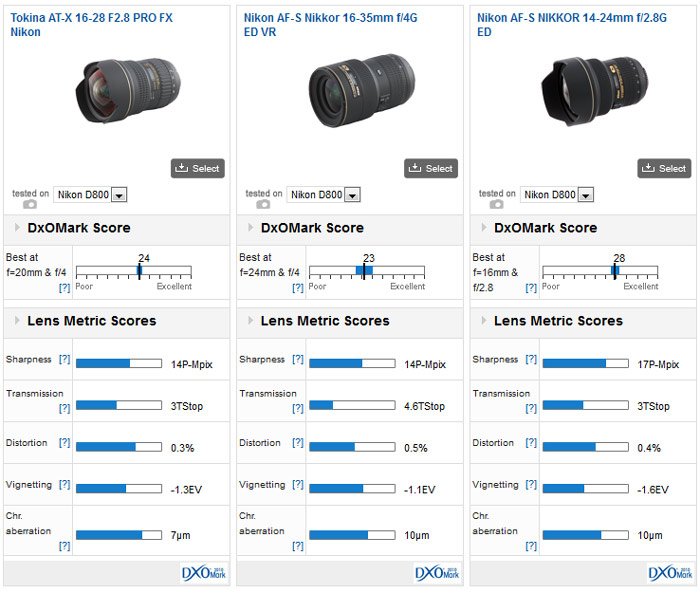
DXOMARK encourages its readers to share comments on the articles. To read or post comments, Disqus cookies are required. Change your Cookies Preferences and read more about our Comment Policy.